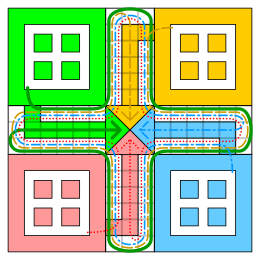This article is about the board game. For other uses, see Ludo (disambiguation).
 An early commercial Ludo board | |
| Years active | Since c. 1896 |
|---|---|
| Genres | Board game Race game Dice game |
| Players | 2–4 |
| Playing time | < 90 min |
| Chance | High (dice rolling) |
| Age range | 3+ |
| Skills | Strategy, tactics, counting, probability |
Ludo (/ˈljuːdoʊ/; from Latin ludo '[I] play') is a strategy-based board game for two to four[a] players, in which the players race their four tokens from start to finish according to the rolls of a single die. Like other cross and circle games, Ludo originated from the Indian game Pachisi.[1] The game and its variations are popular in many countries and under various names.
History
[edit]
Pachisi was created in India in the sixth century CE. It was modified to use a cubic die with a die cup and patented as "Ludo" in England in 1896.[b][2][3]The origin of Ludo is from Hindu Mythology, the Mahabharata Tale, which Ludo was known as Pachisi or “Pasha.” The Mahabharata tale tells a story of a war between two families, the Pandavas and the Kauravas. Although there is no true answer the Ludo was found on historic Ellora Caves in Maharashtra linking mythology to this game. Some say that Alfred Colier invented Ludo but there is evidence that proves that Ludo was from the royal court of Akbar. Colier tried to own the right to Ludo in 1891, renaming his ludo as “Royal Ludo.” [4] Colier was granted that right on the Ludo and gave others duplicates of his version of the game. The Royal Navy took Ludo and converted it into the board game Uckers.[5]
Ludo board
[edit]Special areas of the Ludo board are typically coloured bright yellow, green, red, and blue. Each player is assigned a colour and has four tokens[c] in their colour. The board is normally square with a cross-shaped playspace, with each arm of the cross having three columns of squares, usually six per column. The middle columns usually have five squares coloured; these represent a player's home column. A sixth coloured square not on the home column is a player's starting square. At the centre of the board is a large finishing square, often composed of coloured triangles atop the players' home columns (thus depicting "arrows" pointing to the finish).
Rules
[edit]Overview
[edit]
Two, three, or four can play, without partnerships.[d] At the beginning of the game, each player's four tokens are out of play and staged in the player's yard (one of the large corner areas of the board in the player's colour). When able to, the players enter their tokens one per turn on their respective starting squares and proceed to race them clockwise around the board along the game track (the path of squares not part of any player's home column). When reaching the square below their home column, a player continues by moving tokens up the column to the finishing square. The rolls of a single die[7][8] control the swiftness of the tokens, and entry to the finishing square requires a precise roll from the player. The first to bring all their tokens to the finish wins the game. The others often continue to play to determine second-, third-, and fourth-place finishers.



0 Comments